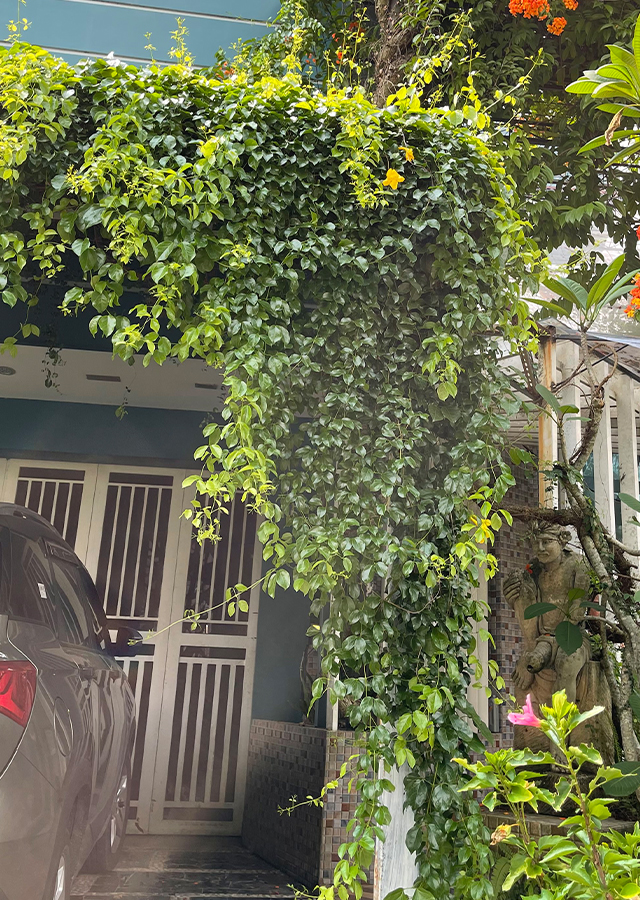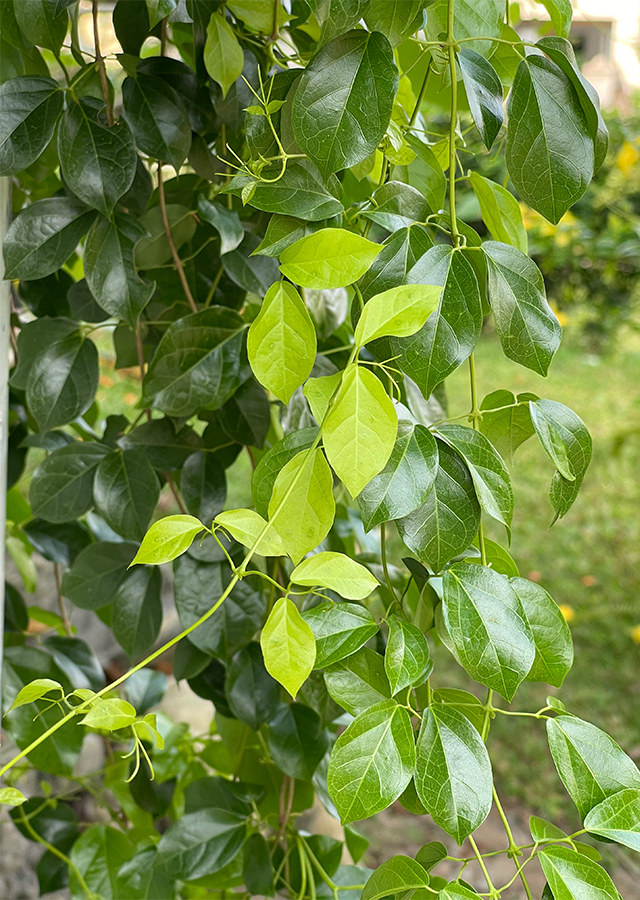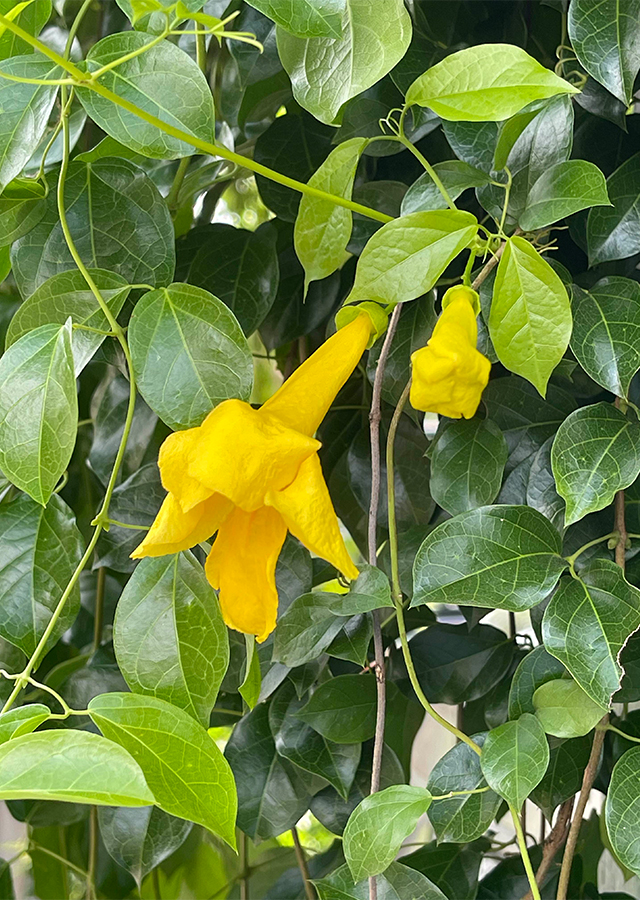Traditional Herbs from Dolichandra unguis-cati
treating_snake_bites
- Prepare enough cat's claw leaves and stems, wash them thoroughly.
- Blend the ingredients until they become a paste.
- Apply the paste to the snake bite.
cough
- Take\u00a0the leaves and stems wash enough cat's claws until clean.
- Boil until boiling.
- Let it warm/cold.
- Strain then drink.
What is Dolichandra unguis-cati Looks like??



Parts of Dolichandra unguis-cati that could be used
- Leaves
- Stems
- All Parts of the Plant
Dolichandra unguis-cati Distribution
The cat's claw plant or D. unguis-cati originates from tropical America, from Mexico to Argentina and the West Indies, including Trinidad and Tobago. This species has been widely commercialized as an ornamental plant and is now naturalized in Asia, Africa, Europe, Australia, and on many islands in the Pacific Ocean. This species also has good health benefits and has been used as a medicinal plant in several countries. One of them is in Guyana, which uses it to treat female infertility and bleeding. This species is also popular in medicine against venereal diseases.Agroecology of Dolichandra unguis-cati
D. unguis-cati is a very aggressive invasive plant in riparian zones and rainforest plant communities. In its native distribution range, the species is found in tropical dry forests, tropical wet forests, lowland and midland rainforests, savannas, seasonally deciduous forests and seasonally flooded forests of the Amazon. In areas where it has naturalized, this species grows in gardens, grasslands, urban open spaces, riverine forests and along roadsides and forest edges in temperate, subtropical and tropical habitats. In the West Indies (i.e., Puerto Rico), it grows from near sea level to elevations of more than 600 m asl, in locations that receive average annual rainfall from about 750 to 2400 mm. The growth of D. unguis-cati prefers a position in full sun or partial shade. Tolerates most soils, except very poorly drained soils. This species is frost hardy and can also survive grazing and fire, but is pushed out by deep grasslands. In Australia it has been found growing around estuarine wetlands, showing a higher tolerance for salty conditions.
Morphology of Dolichandra unguis-cati
- The roots produce tubers that produce stolons (runners).
- Stems are cylindrical, lenticelous, woody, have claw-shaped leaf tendrils and adventitious roots. Younger stems are glabrous and green, often with reddish-brown tips or bronze. Stems turn light brown or grayish and become woody with age (older stems can reach 15 cm or thicker). attached to the support via claw-like leaf tendrils.
- Compound leaves, arranged in pairs along the stem, green in color. Each leaf consists of 2 leaflets (2-foliolate), and a terminal tendril of 3 claws, generally short. oval or ovate, glabrous or with punctiform scales, leaf tip pointed or tapered, leaf base sharp or rounded, leaf edges flat or wavy. However, young seedlings have simple leaves with slightly toothed edges. Upper surface dark, shiny, with concave venation; lower surface light green, dull, with prominent venation.
- Flowers solitary or in pairs, trumpet-shaped, stalk 2 cm long, clustered in leaf axils. The calyx (calyx) is green, conical, 12-16 mm long, with five partially fused sepals (calyx tube). The crown (corolla) is bright yellow with an orange stripe running along the corolla tube or throat, infundibuliform, with five unequal, rounded lobes. Stamens 4 in number, dynamic, inserted. The ovary is covered with punctiform scales.
- The fruit is a flat, linear, slightly woody capsule, initially shiny green, but turns dark brown when ripe.
- Seeds are thin, numerous, 1-3 long, 5 cm, oval in shape with two transparent webbed wings.
Cultivation of Dolichandra unguis-cati
- Plant propagation is by seeds, stem cuttings, a tuberous root system that easily roots at nodes.
- As soon as the seeds germinate, the young plant begins to form an underground tuber that increases in size every year. The capsule matures about six months after flowering.", "Seeds are usually dispersed by wind and water, while tuberous roots can be dispersed by flooding and during human activities involving significant soil movement.
Dolichandra unguis-cati, more details :
Chemical Content of Dolichandra unguis-catiPhenolic compounds, six flavonoids (8, methoxy, acacetin, 7-O glucoside; 6, methoxy apigenin 7-O glucoside; 4‵-O methyl scutellarin, 6-O apiosyl galactoside; acacetin, 7-O glucosyl, 8-C rhamnosyl, 3-O-α arabinofuranoside; 4‵-methyl, 6- methoxy kaempferol, 7-O, 8-C diglucoside and vicenin II), lapachol, quinovic acid, 3-(O-fucosyl) alcohol, β-amyrin, and β-sitosterol.
Benefits of Dolichandra unguis-cati
Reduces heat (fever), treats venereal diseases, coughs, flu and headaches, snake bites, dysentery, diarrhea, inflammation and rheumatism, treats female infertility and bleeding, as a substitute for quinine for malaria. Acts as a diuretic, anti-inflammatory and emollient.
Simplisia of Dolichandra unguis-cati
Another Facts for Dolichandra unguis-cati :
Synonym of Dolichandra unguis-catiBatocydia exoleta Mart. ex DC., Bignonia unguis-cati L., Macfadyena unguis-cati (L.) A.H.Gentry
Habitus of Dolichandra unguis-cati
Creepers. Vines, lianas, annual, can climb up to 15 m or higher
Habitat of Dolichandra unguis-cati
- Wetland", "Riverside", "Forest", "Coastal", "Roadside", "Shrub Area", "Land
No comments:
Post a Comment